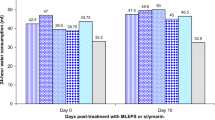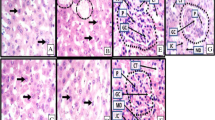Abstract
The aim of this study was to evaluate the possible therapeutic or protective effects of Helichrysum plicatum DC. subsp. plicatum ethanol extract (HPE) against gentamicin-induced nephrotoxicity. Thirty-six Sprague Dawley male rats weighing between 200 and 250 g were used as live material. They were formed into six groups containing 6 rats each and were allowed to adapt to laboratory conditions for 7 d. Group I: control, 5% DMSO intraperitoneal (i.p.); Group II: HPE 100 mg/(kg·d) i.p.; Group III: HPE 200 mg/(kg·d) i.p.; Group IV: gentamicin as 80 mg/(kg·d) i.p.; Group V: gentamicin as 80 mg/(kg·d) i.p.+HPE 100 mg/(kg·d) i.p.; and Group VI: gentamicin as 80 mg/(kg·d) i.p.+HPE 200 mg/(kg·d) i.p. for 8 d. Following treatment, serum, liver, and kidney tissues were used to assess blood urea nitrogen (BUN), creatinine, enzymatic and non-enzymatic antioxidants, and lipid peroxidation. Gentamicin significantly increased serum BUN, creatinin, and liver and kidney levels of malondialdehyde (MDA). It also decreased the activity of catalase (CAT), glutathione peroxidase (GPx), and superoxide dismutase (SOD). Treatment with the HPE 100 mg/kg reversed gentamicin-induced alterations as evidenced by decreased serum BUN and creatinin, liver and kidney oxidant marker, and tubular necrosis as well as by an increase in antioxidant enzymes. It was found that HPE 200 mg/kg significantly increased liver and kidney tissue MDA levels in nephrotoxicity in rats. As a result, these findings support the proposition that HPE in 100 mg/kg dose demonstrates in the kidney and liver as free radicals and scavenger to prevent the toxic effects of gentamicin in both the biochemical and histopathology parameters.
摘要
目的
评估蜡菊乙醇提取物(HPE)对庆大霉素诱导的 肾毒性的治疗或保护作用。
方法
将36 只体重200~250 g 的Sprague Dawley 雄性大 鼠分成6 组,每组6 只,适应实验室条件7 d。 每组处理方式不同,包括:组I,对照组,5% DMSO;组II,HPE 100 mg/(kg·d);组III,HPE 200 mg/(kg·d);组IV,庆大霉素80 mg/(kg·d); 组V,庆大霉素80 mg/(kg·d)+HPE 100 mg/(kg·d);组VI,庆大霉素80 mg/(kg·d)+HPE 200 mg/(kg·d)。 腹腔注射8 d 后,取血清、肝和肾组织用于评估 血液尿素氮(BUN)、肌酐、酶和非酶抗氧化剂 和脂质过氧化。
结论
庆大霉素能显著提升血清BUN、肌酐和肝肾阳 性以及丙二醛(MDA)水平,同时降低过氧化 氢酶(CAT),谷胱甘肽过氧化物酶(GPx)和超氧化物歧化酶(SOD)的活性。用100 mg/kg HPE 的治疗能逆转庆大霉素诱导的改变。因此, 100 mg/kg HPE 在肾脏和肝脏中可作为自由基和 清除剂,具有缓解庆大霉素在生物化学和组织病 理学上毒性的作用。
Similar content being viewed by others
References
Ademiluyi, A.O., Oboh, G., Owoloye, T.R., et al., 2013. Modulatory effect of dietary inclusion of garlic (Allium Sativum) on gentamicin-induced hepatotoxicity and oxidative stress in rats. Asian. Pac. J. Trop. Biomed., 3(6): 470–475. http://dx.doi.org/10.1016/S2221-1691(13)60098-2
Albayrak, S., Aksoy, A., Sagdic, O., et al., 2009. Composition, antioxidant and antimicrobial activities of Helicrysum (Asteraceae) species collected from Turkey. Food Chem., 119(1):114–122. http://dx.doi.org/10.1016/j.foodchem.2009.06.003
Ali, B.H., 2003. Agents ameliorating or augmenting experimental gentamicin nephrotoxicity: some recent research. Food Chem. Toxicol., 41(11):1447–1452. http://dx.doi.org/10.1016/S0278-6915(03)00186-8
Al-Kenanny, E.R., Al-Hayaly, L.K., Al-Badrany, A.G., 2012. Protective effect of Arabic gum on liver injury experimentally induced by gentamicin in mice. Kufa J. Vet. Med. Sci., 3:174–189.
Aslan, M., 2000. Seker hastaligina karsi halkilaci olarak kullanilan bitkiler üzerinde Farmakognozik Arastirmalar. Doktora tezi, Gazi Üniversitesi Saglik Bilimler Enstitüsü farmakognozik Anabilimdali, Ankara, p.216 (in Turkish).
Aslan, M., Orhan, D.D., Orhan, N., et al., 2007. In vivo antidiabetic and antioxidant potential of Helichrysum plicatum ssp. plicatum capitulums in streptozotocin-induceddiabetic rats. J. Ethnopharmacol., 109(1):54–59. http://dx.doi.org/10.1016/j.jep.2006.07.001
Balakumar, P., Rohilla, A., Thangathirupathi, A., 2010. Gentamicin-induced nephrotoxicity: do we have a promising therapeutic approach to blunt it? Pharmacol. Res., 62(3):179–186. http://dx.doi.org/10.1016/j.phrs.2010.04.004
Banday, A.A., Farooq, N., Priyamvada, S., et al., 2008. Time dependent effects of gentamicin on the enzymes of carbohydrate metabolism, brush border membrane and oxidative stress in rat kidney tissues. Life Sci., 82(9-10): 450–459. http://dx.doi.org/10.1016/j.lfs.2007.11.014
Bayer, R.J., Breitwieaser, I., Ward, J., et al., 2007. Tribe Gnaphalieae (Cass.) Lecoq & Juillet (1831). In: Kadereit, J.W., Jeffrey, C. (Eds.), The Families and Genera of Vascular Plants, Asterales. Springer, Berlin, p.246–284.
Corona, P.S., Espinal, L., Rodriguez-Pardo, D., et al., 2014. Antibiotic susceptibility in Gram-positive chronic joint arthroplasty infections: increased aminoglycoside resistance rate in patients with prior aminoglycosideimpregnated cement spacer use. J. Arthropl., 29(8):1617–1621. http://dx.doi.org/10.1016/j.arth.2014.03.029
El-Kashef, D.H., El-Kenawi, A.E., et al., 2015. Protective effect of allicin against gentamicin-induced nephrotoxicity in rats. Int. Immunopharmacol., 29(2):679–686. http://dx.doi.org/10.1016/j.intimp.2015.09.010
Góth, L.A., 1991. Simple method for determination of serum catalase activity and revision of serum catalase activity and revision of reference range. Clin. Chim. Acta, 196(2-3):143–152. http://dx.doi.org/10.1016/0009-8981(91)90067-M
Guner, A., 2012. Turkiye Bitkileri Listesi (The List of Turkish Plants), Namas Matbaacilik San. Tic. A.S., Istanbul, p.163–165 (in Turkish).
Kamel, M.A., Hosny Abdel Fadil, I., Noha, M.A., 2015. Prevention of Hepato-renal toxicity with vitamin E, vitamin C and their combination in gentamicin treated rats. Int. J. Pharma Sci., 5(6):1289–1296.
Kandemir, F.M., Özkaraca, M., Apaydin Yildirim, B., et al., 2015. Rutin attenuates gentamicin-induced renal damage by reducing the oxidative stress, inflammation, apoptosis and autophagy in rats. Ren. Fail., 23:1–8. http://dx.doi.org/10.3109/0886022X.2015
Liu, P., Feng, Y., Dong, D., et al., 2016. Enhanced renoprotective effect of IGF-1 modified human umbilical cord-derived mesenchymal stem cells on gentamicininduced acute kidney injury. Sci. Rep.-UK, 6:20287. http://dx.doi.org/10.1038/srep20287
Mahmood, N., Haleh, M., Mohammad, P., et al., 2014. Pathological changes of gentamicin in liver tissue and antioxidant property of Cinnamon extract on Wistar rats. Biomed. Pharmacol. J., 7(1):341–347. http://dx.doi.org/10.13005/bpj/496
Masakazu, K., Yoshiko, E., Masashi, E., 2014. Acquired resistance of Listeria monocytogenes in and escaped from liver parenchymal cells to gentamicin is caused by being coated with their plasma membrane. Microb. Infect., 16(3):237–243. http://dx.doi.org/10.1016/j.micinf.2013.11.005
Martínez-Salgado, C., López-Hernández, F.J., López-Novoa, J.M., 2007. Glomerular nephrotoxicity of amino nucleosides. Toxicol. Appl. Pharmacol., 223(1):86–98. http://dx.doi.org/10.1016/j.taap.2007.05.004
Matkovics, B., Szabo, L., Varga, I.S., 1988. Determination of enzyme activities in lipid peroxidation and glutathione pathways. Laboratoriumi Diagnosztika, 15:248–249 (in Hungarian).
Mert, N., 1996. Veteriner Klinik Biyokimya. Uludag Universitesi Veteriner Fakultesi Guclendirme Vakfi Yayin 12, Bursa, p.151–153 (in Turkish).
Moreira, M.A., Nascimento, M.A., Bozzo, T.A., et al., 2014. Ascorbic acid reduces gentamicin induced nephrotoxicity in rats through the control of reactive oxygen species. Clin. Nutr., 33(2):296–301. http://dx.doi.org/10.1016/j.clnu.2013.05.005
Morone-Fortunato, I., Montemurro, C., Ruta, C., et al., 2010. Essential oils, genetic relationships and in vitro establishment of Helichrysum italicum (Roth) G. Don subsp. italicum from wild Mediterranean germplasm. Ind. Crops Prod., 32(3):639–649. http://dx.doi.org/10.1016/j.indcrop.2010.07.023
Nasri, H., 2012. Acute kidney injury and beyond. J. Ren. Inj. Prev., 1(1):1–2. http://dx.doi.org/10.12861/jrip.2012.01
Nayma, S., Sadia, C.S.M., Tanveer, H.P., et al., 2012. Effects of Ashwagandha (Withania somnifera) root extract on some serum liver marker enzymes (AST, ALT) in gentamicin intoxicated rats. J. Bangladesh Soc. Physiol., 7(1):1–7. http://dx.doi.org/10.3329/jbsp.v7i1.11152
Ojano-Dirain, C.P., Antonelli, P.J., le Prell, C.G., 2014. Mitochondria-targeted antioxidant MitoQ reduces gentamicin-induced ototoxicity. Otol. Neurotol., 35(3): 533–539. http://dx.doi.org/10.1097/MAO.0000000000000192
Ouédraogo, M., Lamien-Sanoub, A., Ramdeb, N., et al., 2013. Protective effect of Moringa oleifera leaves against gentamicin-induced nephrotoxicity in rabbits. Exp. Toxicol. Pathol., 65(3):335–339. http://dx.doi.org/10.1016/j.etp.2011.11.006
Peng, J., Gones, G.L., Watson, K., 2000. Stress protein as biomarkers of oxidative stress: effects of antioxidant supplement. Free Radic. Biol. Med., 28(11):1598–1606. http://dx.doi.org/10.1016/S0891-5849(00)00276-8
Placer, Z.A., Cushmanni, L.L., Johnson, B.C., 1966. Estimation of products of lipid peroxidation (as malondialdehyde) in biochemical systems. Anal. Biochem., 16(2): 359–364. http://dx.doi.org/10.1016/0003-2697(66)90167-9
Raju, S., Kavimani, S., Maheshwara rao, V.U., et al., 2011. Floral extract of Tecoma stans: a potent inhibitor of gentamicin-induced nephrotoxicity in vivo. Asian Pac. J. Trop. Med., 4(9):680–685. http://dx.doi.org/10.1016/S1995-7645(11)60173-9
Sagdic, O., Karahan, A.G., Ozcan, M., et al., 2003. Effect of some spice extracts on bacterial inhibition. Food Sci. Technol. Int., 9(5):353–356. http://dx.doi.org/10.1177/1082013203038976
Sala, A., Recio, M.C., Schinella, G.R., et al., 2003. Assessment of the anti-inflammatory activity and free radical scavenger activity of tiliroside. Eur. J. Pharmacol., 461(1):53–61. http://dx.doi.org/10.1016/S0014-2999(02)02953-9
Salem, E.A., Salem, N.A., Kamel, M., et al., 2010. Amelioration of gentamicin nephrotoxicity by green tea extract in uninephrectomized rats as a model of progressive renal failure. Ren. Fail., 32(10):1210–1215. http://dx.doi.org/10.3109/0886022X.2010.517350
Sezik, E., Yesilada, E., Honda, G., et al., 2001. Traditional medicine in Turkey. X. Folk medicine in Central Anatolia. J. Ethnopharmacol., 75(2-3):95–115. http://dx.doi.org/10.1016/S0378-8741(00)00399-8
Shrestha, B., Haylor, J., 2014. Experimental rat models of chronic allograft nephropathy: a review. Int. J. Nephrol. Renovasc. Dis., 23(7):315–322. http://dx.doi.org/10.2147/IJNRD.S65604
Singh, A.P., Junemann, A., Muthuraman, A., et al., 2012. Animal models of acute renal failure. Pharmacol. Rep., 64(1):31–44. http://dx.doi.org/10.1016/S1734-1140(12)70728-4
Smirnov, V., Preobrazheskaia, N., Kalashnikov, I., 1982. Antibacterial properties of Helichrysum plicatum. Mikrobiol. Z., 44:71–72.
Stafford, G.I., Jäger, A.K., van Staden, J., 2005. Effect of storage on the chemical composition and biological activity of several popular South African medicinal plants. J. Ethnopharmacol., 97(1):107–115. http://dx.doi.org/10.1016/j.jep.2004.10.021
Stojiljkovic, N., Stoiljkovic, M., 2006. Micromorphological and histochemical characteristics of a rat’s liver treated with gentamicin. Acta Medica Medianae, 45(3):24–28.
Sumbul, H., Gokturk, R.S., Dussen, O.D., 2003. A new endemic species of Helichrysum Gaertn. (Asteraceae-Inuleae) from south Anatolia. Bot. J. Linn. Soc., 141(2):251–254. http://dx.doi.org/10.1046/j.1095-8339.2003.00109.x
Sun, Y., Oberley, L.W., Li, Y.A., 1988. Simple method for clinical assay of superoxide dismutase. Clin. Chem., 34(3): 497–500.
Süzgec, S., Mericli, A.H., Houghton, P.J., et al., 2005. Flavonoids of Helichrysum compactum and their antioxidant and antibacterial activity. Fitoterapia, 76(2):269–272. http://dx.doi.org/10.1016/j.fitote.2004.12.006
Tavafi, M., 2013. Protection of renal tubules against gentamicin induced nephrotoxicity. J. Ren. Inj. Prev., 2(1):5–6. http://dx.doi.org/10.12861/jrip.2013.03
Tavafi, M., Ahmadvand, H., 2011. Effect of rosmarinic acid on inhibition of gentamicin induced nephrotoxicity in rats. Tissue Cell, 43(6):392–397. http://dx.doi.org/10.1016/j.tice.2011.09.001
Veljkovic, M., Pavlovic, D.R., Stojiljkovic, N., et al., 2016. Morphological and morphometric study of protective effect of green tea in gentamicin-induced nephrotoxicity in rats. Life Sci., 147:85–91. http://dx.doi.org/10.1016/j.lfs.2016.01.035
Wang, Y., Iwatani, H., Ito, T., et al., 2004. Fetal cells in mother rats contribute to the remodeling of liver and kidney after injury. Biochem. Bioph. Res. Commun., 325(3):961–967. http://dx.doi.org/10.1016/j.bbrc.2004.10.105
Yaman, I., Balikci, S., 2010. Protective effect of Nigella sativa against gentamicin-induced nephrotoxicity in rats. Exp. Toxicol. Path., 62(2):183–190. http://dx.doi.org/10.1016/j.etp.2009.03.006
Acknowledgments
The authors would like to thank Unsal Sami AKTAS (Ani-Med Pharmacy, Turkey) for the financial support and Meryem SENGUL (Department of Botanic, Faculty of Agriculture, Ataturk University, Erzurum, Turkey) for identifying Helichrysum plicatum DC. subsp. plicatum plant.
Author information
Authors and Affiliations
Corresponding author
Additional information
ORCID: Betul APAYDIN YILDIRIM, http://orcid.org/0000-0002-0361-6148
Rights and permissions
About this article
Cite this article
Apaydin Yildirim, B., Kordali, S., Terim Kapakin, K.A. et al. Effect of Helichrysum plicatum DC. subsp. plicatum ethanol extract on gentamicin-induced nephrotoxicity in rats. J. Zhejiang Univ. Sci. B 18, 501–511 (2017). https://doi.org/10.1631/jzus.B1500291
Received:
Accepted:
Published:
Issue Date:
DOI: https://doi.org/10.1631/jzus.B1500291
Key words
- Antioxidants
- Extract
- Gentamicin
- Helichrysum plicatum DC. subsp. plicatum
- Nephrotoxicity
- Oxidative stress




